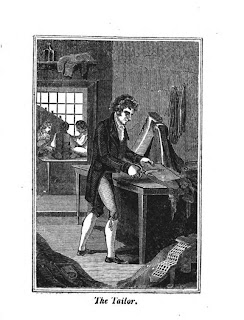Loretta reports:
Following is a short excerpt from a wonderful resource, The book of English trades: and library of the useful arts : with seventy engravings, by John Souter. 1818
THE TAILOR.
THE Tailor makes clothes for men and boys, and riding-habits for ladies.
In a tailor's shop, where much business is carried on, there are always two divisions of workmen: first, the foreman, who takes the measure of the person for whom the clothes are to be made, cuts out the cloth, and carries home the newly-finished garments to the customers. The others are mere working tailors, who sit cross-legged on the bench, like the man near the window, represented in the plate; of these, very few know how to cut out, with any degree of skill, the clothes which they sew together.
The tools requisite in the business of a tailor are very few and unexpensive: the sheers for the foreman, who stands to his work; for the others, a pair of scissors, a thimble, and needles of different sizes. In the thimble there is this peculiarity, that it is open at both ends. Besides these, there are required some long slips of parchment for measures, such as those represented hanging against the wall, and an iron, called a goose, with this, when made hot, they press down the scams, which would otherwise take off from the beauty of the goods. The stand of iron is generally a horse-shoe, rendered bright from use. Before the foreman, or master, (for where the trade is not extensive the master cuts out, measures gentlemen, and carries home the clothes,) is an open box, this contains buckram, tapes, bindings, trimmings, buttons, &c. with which every master-tailor should be furnished, and from which they derive very large profits. On the shelf is a piece of cloth ready to be made into clothes, and also a pattern-book.
....
A writer on this subject says, that a master-tailor ought to have a quick eye to steal the cut of a sleeve, the pattern of a flap, or the shape of a good trimming, at a glance : any bungler may cut out a shape when he has a pattern before him; but a good workman takes it by his eye in the passing of a chariot, or in the space between the door and a coach: he must be able not only to cut for the handsome and well-shaped, but bestow a good shape where nature has not granted it: he must make the clothes sit easy in spite of a stiff gait or awkward air : his hand and head must go together : he must be a nice cutter, and finish his work with elegance.


No comments:
Post a Comment